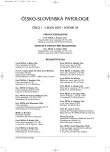The Use of Cell Cultures for in Vitro Decompression Sickness Simulation
Authors:
M. Palkovič 1; F. Novomeský 2; M. Zaviačič 1; Ľudovít Danihel 1; P. Kováč 3; Ľ. Danišovič 4
Authors‘ workplace:
Ústav lekárskej biológie a genetiky LF UK, Bratislava
; Ústav súdneho lekárstva JLF UK, Martin
; Ústav súdneho lekárstva LF UK, Bratislava
; Ústav patologickej anatómie LF UK, Bratislava
Published in:
Soud Lék., 52, 2007, No. 1, p. 9-16
Overview
Recreational and technical diving in the past twenty years have become extraordinary popular. Until then diving was a priority of police, army and scientists. Today more and more enthusiasts are exposed to abnormally high surrounding pressure. To the severest of all risks associated with diving, decompression sickness is the greatest threat. Even the most advanced scientific approaches yet did not reveal the complex mechanisms of decompression sickness formation. The majority of experiments use a live model for decompression sickness studies. This is associated with high fatality rate. The new approach of this scientific study is in the use of an in vitro working media as a means of visualization of gas bubbles due to decompression.
The aim of this study is to bring above new approaches in in vitro gas bubble formation during decompression. Main goals are: development of in vitro inert gas bubble visualization and evaluation techniques after a real decompression dive with air a as the diving gas and EANx50 as a decompression gas.
We selected cell cultures derived from human fibroblasts B-HEF-2 and cell cultures of mice N2A neuroblasts. We used two decompression profiles. “Explosive” decompression profile with a linear compression to overpressure of 50 bar with an rapid decompression to atmospheric pressure (1 bar). In simulation of a realistic decompression profile we used compressed air as a mean for compression and isocompression breathing gas and an EANx50 blend as a decompression breathing gas. This dive was planned with the use of a VPM-B decompression profile by V-Planner software v.3.62.
Our latest experiments show that DNA fragmentation and apoptosis is activated during decompression shock. Use of culture cells can be of great value in further studies of decompression changes in the cellular and subcellular level.
Key words:
decompression – decompression sickness – decompression shock – fibroblast – neuroblast – cell cultures – VPM – B-HEF-2 – N2A
Labels
Anatomical pathology Forensic medical examiner ToxicologyArticle was published in
Forensic Medicine

2007 Issue 1
Most read in this issue
- Severity of Opiate Intoxication to Gender and Age
- Toxicological Criterion of the Heroin Poisoning
- Medicolegal Practise in Florida, USA
- The Use of Cell Cultures for in Vitro Decompression Sickness Simulation
